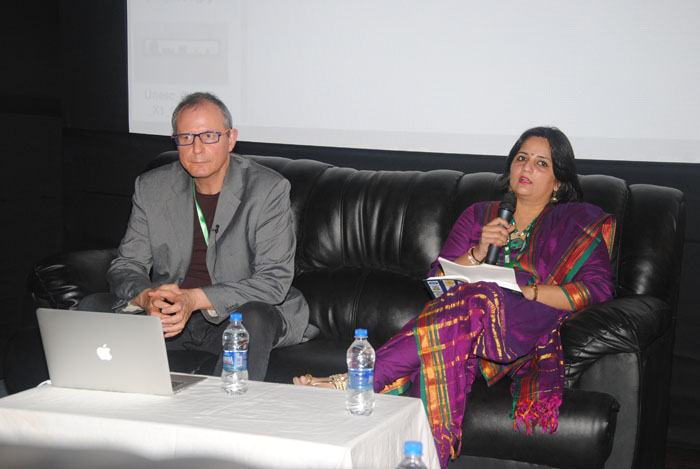NEW DELHI: Animation always endears itself to audiences, but what came as a pleasant surprise was that conventional puppet and drawing animation proved as popular in an era of computer animation.
Three packages of animation films – two from Latvia and one from Italy – and a master class by a renowned Italian film festival director surprised many by the attention they received. The package had been curated for the Films Division by award-winning animation filmmaker Dhvani Desai who had also curated packages from Estonia and Bulgaria at the last MIFF.
Luca Raffaelli, the Italian who held the Master Class, is considered one of the greatest Italian experts in the field of comics and animation and is responsible for promoting an important role in the national cultural scene, both as a journalist and as a writer of essays.
Raffaelli’s Master Class on the nuances of screenplay writing for animation films was attended by noted people in the field of cinema including Jackie Shroff who is the brand ambassador of the Festival (who marked his birthday learning about animation at the Master Class) and Film and Television Institute of India Chairman Gajendra Chauhan.
In an interview, Luca told Festival News that there was dire need to educate producers and broadcasters on the need to develop the animation format at it appealed to people of all ages and could be suitably used as a tool for imparting information and education besides entertainment.
He said currently, the scenario is very conducive to animation films all over the world as the market is growing and developing space for new ideas.
He was excited to have been invited to India and said he had seen some interesting films and hoped to see more.
Since 1994, Luca has been writing a column entitled Nuvolette on Lanciostory and has been writing on animation and comics on XL, the monthly of the Republic, on the Friday of the Republic and of the Republic. He has also edited the series of the classic cartoon series The gold , The Encyclopedia of the strips , Graphic-novel , the historical collection Color Tex , and that of Zagor .

In 1994 he published the essay “The souls drawn. The thought in the cartoon from Disney to the Japanese “, which became a reference book for everyone involved in animation in Italy, and in 1997 “Comics” (Basic Books – Flammarion), which reviews the different formats in which it is proposed the ninth art, tracing the centennial history.
He also published two children’s books, “A ghost in the kitchen” and “Gianga and Perepè”). He was the artistic director of Castelli Cartoons, the International Festival of Animation Film Genzano, as well as Romics, the festival of comics and animation of Rome. As writer, among other works, he collaborated in 2002 with Julius Track and Dario Fo in the animated feature film Johan Padan TO THE DISCOVERY of the Americas , and in 2003 in the first Italian animated film in 3D, The ltttle Bee. Since 2008, he is part of the scientific committee of the magazine Manga Academica, the first magazine of studies on the comic and Japanese animation.
Dhvani, who put together the packages and also invited Luca, said though she was a computer animator, she felt there was a lot of interest even in conventional hand-drawn, puppet, or sand animation.
Justifying her selection, she said both Latvia had Italy had different styles, and one of the two packages from Latvia had featured animation classics by Arnolds Burovs. She also found the puppet animation in Latvia very fascinating. She had also found that though Latvia had been through turbulent times, all the films were light and full of happiness.
On the other hand Italian animators dabbled in abstract, surrealistic, and even religious subjects.
Asked what should be done to promote animation films in India, she said the government can set aside at least one hour every day for animation films. She also felt that Mumbai was the best venue for a Centre of Excellence in Animation and Special effects.
Dhvani, who has served on several juries, has made three major animation films in her 25 years in the field. The first was on ‘The Mahatma’ stressing the ideals of Mahatma Gandhi, the second ‘Manpasand’ touched on women empowerment, while the third ‘Chakravyuh’ was on the Right to Information. All the three had won several awards in India and overseas and and ‘Chakravyuh’ got the award of the most popular film at MIFF.
In addition, she attempted to bring special effects and animation to the large number of commercial films she makes.
Although she did not receive any formal training in art, Dhvani said her family backed her when she wanted to go into that field. She said she came from a very creative family – as her father is a renowned poet and her mother writes short stories – and they all supported her, and her brother Sanskar is a documentary filmmaker and sister Sanskritirani is also a poet.
